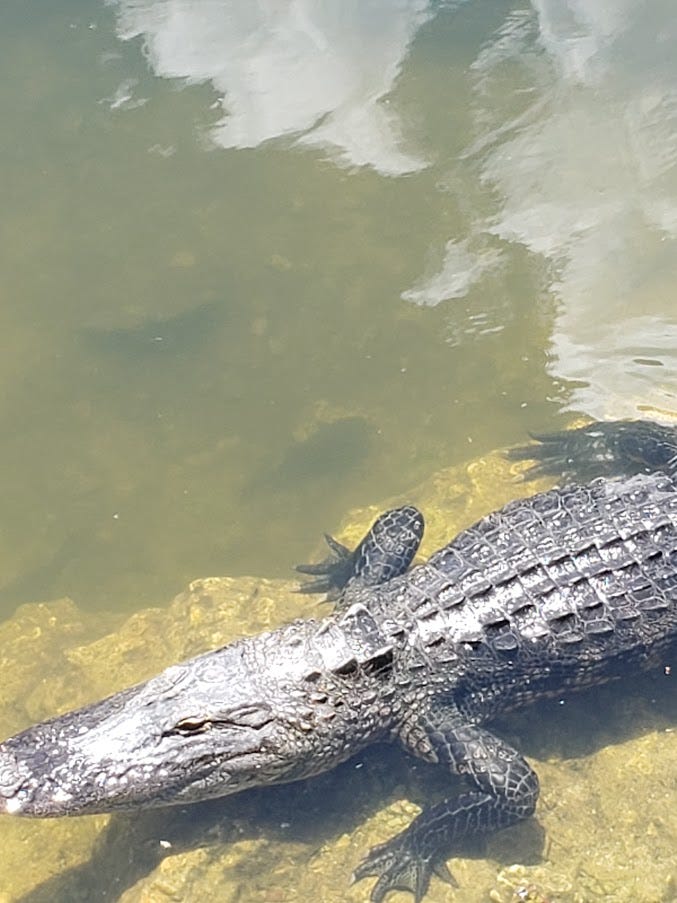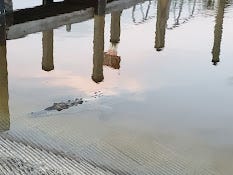Since I last posted, we spent a very nice couple of days in Central Florida and had a chance to visit with Bill and Kathy Buick in Ormond beach and Tom’s brother in law Ron, nephew Lee and his wife Sam near Deland. Tom met his grandnephew, TJ, for the first time as well. TJ was 17 months of cute and the best behaved toddler I have ever met (sorry kids).
From there we went to South Florida, stopping to camp just outside of Palm Springs where we got to meet a very large alligator from the safety of a pontoon boat. Continuing south, we began to see fields and fields of young sugarcane and field worker housing nearby. Many fruit stands and nurseries lined the roads. Years ago, an effort was made to drain the swampland in south Florida to create farmland. In 1947, Everglades was made a National Park, protecting that fragile ecosystem from further destruction. There remain many fruit and vegetable farms as well as sugarcane operations in that area. Near Palm Beach, the division between rich and poor is very stark, with farmworkers living very hard lives for the benefit of so many. There must be a way to get the country fed and take better care of these essential workers.
We spent the next two nights camping in the Flamingo campground in the Everglades. It is the “shoulder season” between winter and summer there. The bugs (mosquitoes and noseeums which come straight up from hell) are active from around 8pm to 8am and are annoying enough to wake you up if there is the smallest gap in your screen system. The temperature rose to 90 degrees during the day, which it turns out is too hot for the bugs (poor things) so we did not have to contend with the heat and the bugs at the same time.
We were able to see both crocodiles, who live in salt water, and alligators, who live in fresh, in different areas of the park. It is an amazing ecosystem, unique and fragile. I wish I could advise on when to go to miss both the heat and the bugs, but threading that needle is nearly impossible as it seems to change from year to year. February seems to be the consensus opinion.
The Everglades is home to one of the largest Mangrove forests in the world. The water in the southern part of the park is brackish and is the perfect climate for these trees. Their root system is intertwined with their neighbors, making the landscape impassable for most creatures. The roots that go into the water are the same color as the crocodiles they help hide along the banks.
Upon leaving the Everglades today, we drove through the Big Cyprus National Preserve, which sits just above the Everglades. There is more fresh water there and we saw alligators sleeping in the sun in shallow ponds. Alligators sleep up to 17 hours a day, waking at night to feed and do whatever else alligators do – it is currently mating season by the way. Seems like a nice life.
We reached our next campsite at 3pm. There was little shade, 91 degrees on the thermometer, no breeze, and some biting insects to welcome us. Fortunately, there was a lovely establishment just down the road serving ice cold beer on tap for cash paying customers. If I ramble, blame it on my immediate need for therapeutic rehydration on an impossibly hot day.
Things I have learned the past few days:
May in South Florida is like August in Pennsylvania . I can’t even imagine August in South Florida
Using DEET as your only hair product for several days gives your hair a very unusual sheen
Alligators live in fresh water, crocodiles in salt water and both can be found in the Everglades
Keep cool, will update soon on travelling through the panhandle.



Never could understand why so many people like Florida so much. Not only is it hot and buggy, it’s flat and it’s not green.
We all learned about King Cotton and the agribusiness that went along with growing, picking and selling it and how the production of cotton increased the amount of slave labor on those farms. Sugarcane was also a highly significant and equally, if not more important contributor to the perpetuation of the slave trade and forced labor. Before sugarcane was grown in America it was a rare commodity and it turned out to be a huge income producer in this country once it moved from Caribbean farms to farms in Georgia, Florida and Louisiana. Sugarcane farming became a huge money making agribusiness in the United States. Once the slave trade was outlawed, the practice of selling slaves children, spouses, brothers and sisters increased and many of them went to sugarcane plantations.